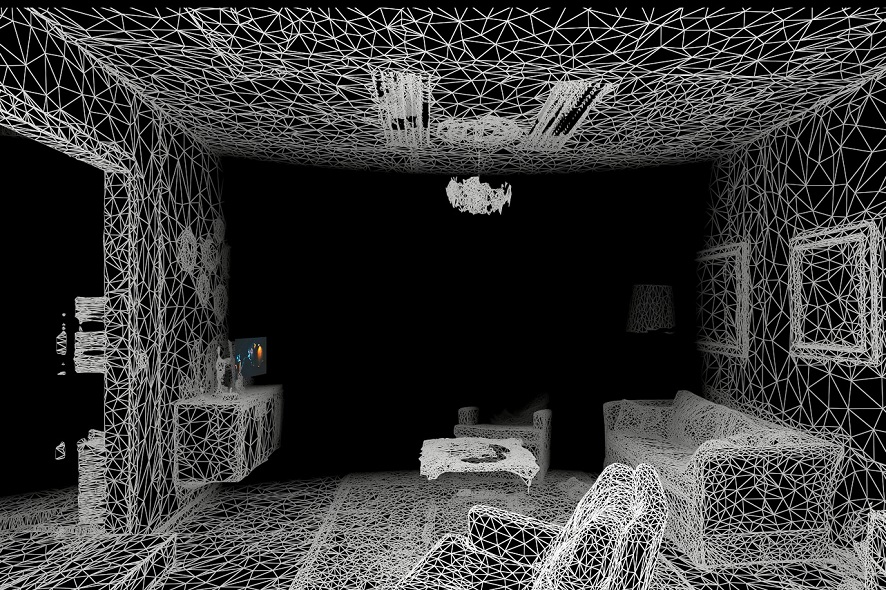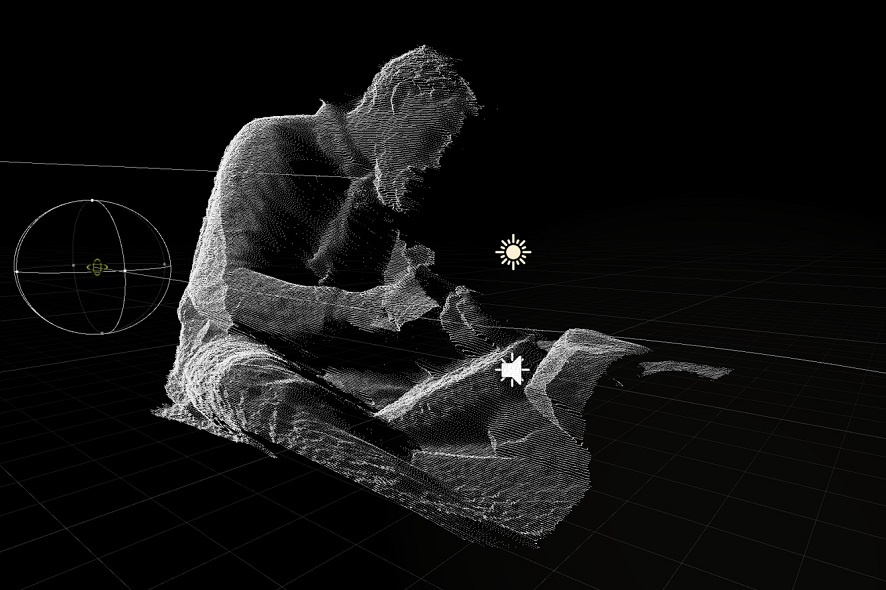The Cyberräuber, the theater of virtual reality, is a collaborative project by Björn Lengers and Marcel Karnapke who, together with artists from the world of theater and stage-based performance, explore ways in which theater and virtual reality (VR) can complement each other.
The Ars Electronica Center will feature one of their projects in the Long Night of the Stages on November 11th: “The Memories of Borderline”, is an original work by the Cyberräuber; its subject is the virtual recollection of a play. Another project, “Pitoti Prometheus”, was created by Marcel Karnapke and director Frederik Baker; it brings to life ancient petroglyphs, artistic images incised into rock surfaces. The piece won a HALO Award this year, honoring outstanding projects within the field of AV/VR/MR.
Björn Lengers and Marcel Karnapke tell us more in this interview.

Credit: Robert Bauernhansl
Your collaborative project Cyberräuber brings together theater and VR. Why do these two modes of expression complement one another so well? What does VR bring to the theater that’s not already there, and, on the other hand, how does the theater make use of VR?
Marcel Karnapke: VR is a totally new medium, whose effect and breadth we’ve only just begun to explore. The question we asked ourselves was: How does one approach a new medium and then go about discovering rules and structures with which one can play and formulate things. We’re approaching this medium as a new space for human experience in which we enable feelings, moods and places to become narratives. Just like the theater, we combine settings with acting and extraordinary perspectives on the part of the spectators to repeatedly come up with new takes on the potential of VR. Conversely, VR is immensely useful to the theater especially when it comes to confronting audiences with stage sets consisting of impossible locations and images. VR makes it possible for spectators as well as cast members to assume positions that are not normally feasible. This opens up new theatrical possibilities, comparable to the development of projections and screens that are now so often utilized in plays performed on stage.
One of the works that emerged in this context is “The Memories of Borderline” that will be performed on the Long Night of the Stages. Tell us about the origins of this project and how exactly it entails a mixture of theater and VR.
Björn Lengers: Originally, Kay Voges, the director of “Die Borderline Prozession”, the play our work is based on, was planning to shoot a film about it. But since an inherent element of its mise-en-scéne is the simultaneity of actions taking place on multiple stages, it was almost impossible to portray this play in a linear medium like film. Accordingly, this gave rise to the idea of turning over power and control to the spectators themselves, who could then actively establish their own point of view on what’s transpiring on stage and, thanks to VR, change perspectives at will. The amalgamation of VR and theater means that parts of the stage and of the videos and sound track of the actual play can be experienced anew in VR and this permits the play to be seen in a new light.

Credit: Cyberräuber
Your work doesn’t deal directly with the play “Die Borderline Prozession” but rather with a recollection of a performance of it, or, perhaps, with its essence. Why so?
Björn Lengers: An exact copy of the play for VR isn’t a good idea for various substantive, technical and artistic reasons. Theater, due to its immediacy and transience, has an aura that can’t be represented in terms of a drawing, a film or a reconstruction. Thus, our declared objective here was to create a work that would permit even the actors who were performing it to gain a new perspective of its spaces, dialog and experiences. The “Memories of Borderline” are a sort of meditation on fleeting and bygone phenomena, on the fragmentariness of our thoughts and memories, and their representation in digital systems like a computer or, as here, virtual reality.
The Long Night of the Stages will also feature “Pitoti Prometheus”, a work in which petroglyphs come alive when viewed through VR glasses. Herr Karnapke, how did you come up with this idea?
Marcel Karnapke: Director Frederick Baker and I got acquainted at Bauhaus University in Weimar in 2012 when he was in search of new media and narrative forms to capture and interpret these millennia-old images carved into stone. Even to this day, archeologists still primarily use two-dimensional photography to document these artifacts, but, in my opinion, the subjectivity in the perspective of these “catalog photos” doesn’t do justice to these works of art, and the 3D scan systems that were emerging at the time seemed to be a good way to document the figures more comprehensively. When Björn, Fred and I then viewed these artifacts together in VR for the first time, even the computer scientists were tremendously impressed by this World Cultural Heritage site. So for us, it was simply the next logical step to perform research in an effort to bring these figures back to life in accordance with the vision of their creators.

Credit: Frederick Baker, Marcel Karnapke
This work is often characterized as “completely novel”. What makes it so extraordinary?
Marcel Karnapke: One of the ideas for our work was to question the material. We want to know what was going through the minds of the artists who, thousands of years ago, kneeled on stone while creating these objects. Were they comparable to us or totally dissimilar? What did their world of ancestors look like; could they already have had concepts of gods; or were the images meant for rituals? Capturing the objects via laser scan at a degree of definition down to only a few millimeters made it possible for us to 3-D print the objects, to endow their limbs with joints, and to actually set these figures in motion. We realized that many objects and figures presumably did not represent an individual portrait but were more along the lines of a stop-action shot—sort of like one frame in a motion picture. So, what if we could recreate the prior and subsequent frames? How would the figures look when they resumed their motions, and could we reanimate them in a way that’s faithful to the prehistoric artist and his vision? This process of considering the figures through the lens of their potentially animated state helped us to pose many new questions and to visually depict their answers. As we went about this, virtual reality wasn’t just a gimmick or a purely visual aesthetic. In fact, these figures are spatial beings in stone in the Northern Italian Alps. Our animated sequences enable the figures to free themselves from the stone; their movements become spatial and thus transcend the limits of a conventional 3D cinematic experience.
Cyberräuber is a Berlin-based art & technology collective that blends theater and virtual reality. Its members are Björn Lengers and Marcel Karnapke. Their work takes the form of theater installations, walk-through settings and, soon, downloadable content for home enjoyment.
Two projects by Björn Lengers and Marcel Karnapke will be featured at the Long Night of the Stages on November 11, 2017 in Deep Space 8K at the Ars Electronica Center—“The Memories of Borderline” at 7PM; “Pitoti Prometheus” at 9 PM. Complete information about these and all other events on the lineup is available on the website of Die Lange Nacht der Bühnen 2017.
To learn more about Ars Electronica, follow us on Facebook, Twitter, Instagram et al., subscribe to our newsletter, and check us out online at https://ars.electronica.art/news/en/.
